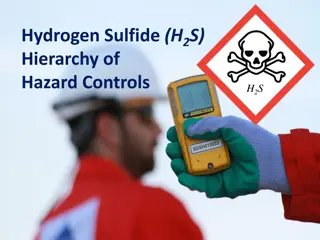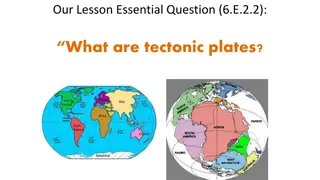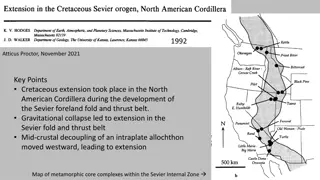Tectonic Controls of the Sevier-Laramide Orogeny
The Sevier-Laramide orogeny was influenced by crustal thickening and gravitational extensional collapse. The tectonic model proposed suggests that conductive heating from subduction weakened the crust, leading to compression, uplift, and lateral growth. Deformation persisted from the Cretaceous to the Tertiary period in the western North American Cordillera, with key events like extensional collapse in the Great Basin hinterland and intrusion of peraluminous plutons. The southern Cordillera underwent uplift, cooling, erosion, and pluton intrusion post-65 Ma. Dike trends indicate northwest-southeast extension during this period.
Download Presentation

Please find below an Image/Link to download the presentation.
The content on the website is provided AS IS for your information and personal use only. It may not be sold, licensed, or shared on other websites without obtaining consent from the author.If you encounter any issues during the download, it is possible that the publisher has removed the file from their server.
You are allowed to download the files provided on this website for personal or commercial use, subject to the condition that they are used lawfully. All files are the property of their respective owners.
The content on the website is provided AS IS for your information and personal use only. It may not be sold, licensed, or shared on other websites without obtaining consent from the author.
E N D
Presentation Transcript
1991 Purpose: Argues that crustal thickening and gravitationally driven extensional collapse are an additional major tectonic control from the evolution of the Sevier-Laramide orogeny. Atticus Proctor, October 2021
Proposed Tectonic Model of Crustal Thickening and Extensional Collapse Key Point: In a Cordilleran setting, deep conductive heating of the orogenic crust induced by subduction decreases crustal strength In a Cordilleran setting, deep conductive heating of the orogenic crust induced by subduction decreases crustal strength. Compressive forces drive crustal thickening and uplift After reaching maximum elevation, the uplifted region can grow laterally Plateaus higher than 3km can gravitationally collapse and extend laterally, the author believes this happened in the Basin and Range during the Sevier-Laramide Orogeny http://www.luckysci.com/2015/10/how-the-west-was-made-western-north-american-orogenies/
Regional Tectonic Scenario Sevier-Laramide orogeny persisted from Cretaceous to early Tertiary time (120-35 Ma) Fold-thrust deformation began circa 120 Ma along the western NA Cordillera and deformation intensified by 105-100 Ma due to an increase in Farallon-North American plate convergence rate. Increased subduction induced conductive heating of hinterland crust thus reducing lithospheric strength and leading to more effective crustal thickening in the hinterland Late Cretaceous extensional collapse took place in the Great Basin hinterland (90-65 Ma)
Regional Tectonic Scenario Peraluminous plutons intruded into the Great Basin between 90 and 70 Ma Increase in plutonism is indicative of a rising geothermal gradient Major hinterland deformation and peak metamorphism between 90 and 70 Ma Between 90 and 65 Ma crustal thickening, magmatism, and deformation sweep south and progress eastward across the Cordillera
Regional Tectonic Scenario Post 65 Ma the southern Cordillera undergoes rapid isostatic uplift, cooling, erosion and intrusion of peraluminous plutons until 35 Ma Significant amounts of normal faulting across the southern Cordillera is evidence for uplift Isotopic cooling dates show reinforce uplift during this period of time Dike trends in southern Cordillera suggest northwest- southeast extension (75-50 Ma)
Discussion Interpreted from preserved strata that the Great Basin hinterland had lower plateau elevations than the southern Cordillera Crustal thickening and extensional collapse can be tied to the structural evolution of the Laramide age Rocky Mountain Foreland Crustal thickening widened until it hit the rigid Colorado Plateau (ca. 80-75 Ma), the locus of deformation then go transferred to the Laramide Rocky Mountain foreland Author interprets that collapse of the southern Cordillera between 65 and 35 Ma drove the Colorado Plateau north/northwest Backed by evidence of a late Laramide Rock Mountain foreland deformation
Key Points of understanding the evolution of the Great Basin Convergence forces and conductive heating of the crust led to crustal thickening in the Sevier-Laramide hinterland Crustal thickening widens, until 80 to 75 Ma when it hits strong Colorado Plateau lithosphere, as evidenced by the migration of the locus of deformation moving east. Extensional collapse thickened crust in the southern Cordillera between 75 and 35 Ma, pushing the Colorado Plateau block northeast Deformation in northern Cordillera ceased ca 56 Ma, where as deformation continued into the Eocene in the central and southern Cordillera
Works cited http://www.luckysci.com/2015/10/how-the-west-was-made- western-north-american-orogenies/























